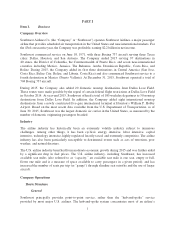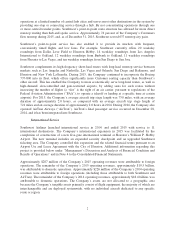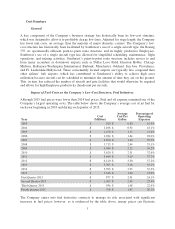Southwest Airlines 2015 Annual Report Download - page 17
Download and view the complete annual report
Please find page 17 of the 2015 Southwest Airlines annual report below. You can navigate through the pages in the report by either clicking on the pages listed below, or by using the keyword search tool below to find specific information within the annual report.indirectly affect the Company and/or the airline industry financially and/or operationally. Examples of
regulations affecting the Company and/or the airline industry, imposed by several of these
governmental agencies and legislative bodies, are discussed below.
Economic and Operational Regulation
Consumer Protection Regulation by the U.S. Department of Transportation
The U.S. Department of Transportation (the “DOT”) regulates economic operating authority for air
carriers and consumer protection for airline passengers. The Federal Aviation Authority (“FAA”), a
sub-agency of the DOT, regulates aviation safety. The DOT may impose civil penalties on air carriers
for violating its regulations.
To provide passenger transportation in the United States, a domestic airline is required to hold both a
Certificate of Public Convenience & Necessity from the DOT and an Air Carrier Operating Certificate
from the FAA. A Certificate of Public Convenience & Necessity is unlimited in duration, and the
Company’s certificate generally permits it to operate among any points within the United States and its
territories and possessions. Additional DOT authority, in the form of a certificate or exemption from
certificate requirements, is required for a U.S. airline to serve foreign destinations either with its own
aircraft or via code-sharing with another airline. Exemptions granted by the DOT to serve international
markets are generally limited in duration and are subject to periodic renewal requirements. The DOT
also has jurisdiction over international tariffs and pricing in certain markets. The DOT may revoke a
certificate or exemption, in whole or in part, for intentional failure to comply with federal aviation
statutes, regulations, orders, or the terms of the certificate itself.
The DOT’s consumer protection and enforcement activities relate to areas such as unfair and deceptive
practices and unfair competition by air carriers, deceptive airline advertising (concerning, e.g., fares,
ontime performance, schedules, and code-sharing), and violations of rules concerning denied boarding
compensation, ticket refunds, and baggage liability requirements. The DOT is also charged with
prohibiting discrimination by airlines against consumers on the basis of race, religion, national origin,
or sex.
Under the above-described authority, the DOT has adopted so-called “Passenger Protection Rules,”
which address a wide variety of matters including flight delays on the tarmac, chronically delayed
flights, denied boarding compensation, and advertising of airfares, among others. Under the Passenger
Protection Rules, U.S. passenger airlines are required to adopt contingency plans that include the
following: (i) assurances that no domestic flight will remain on the airport tarmac for more than three
hours and that no international flight will remain on the tarmac at a U.S. airport for more than four
hours, unless the pilot-in-command determines there is a safety-related or security-related impediment
to deplaning passengers, or air traffic control advises the pilot-in-command that returning to the gate or
permitting passengers to disembark elsewhere would significantly disrupt airport operations; (ii) an
assurance that air carriers will provide adequate food and potable drinking water no later than two
hours after the aircraft leaves the gate (in the case of departure) or touches down (in the case of arrival)
if the aircraft remains on the tarmac, unless the pilot-in-command determines that safety or security
considerations preclude such service; and (iii) an assurance of operable lavatories, as well as adequate
medical attention, if needed. Air carriers are required to publish their contingency plans on their
websites.
9
























